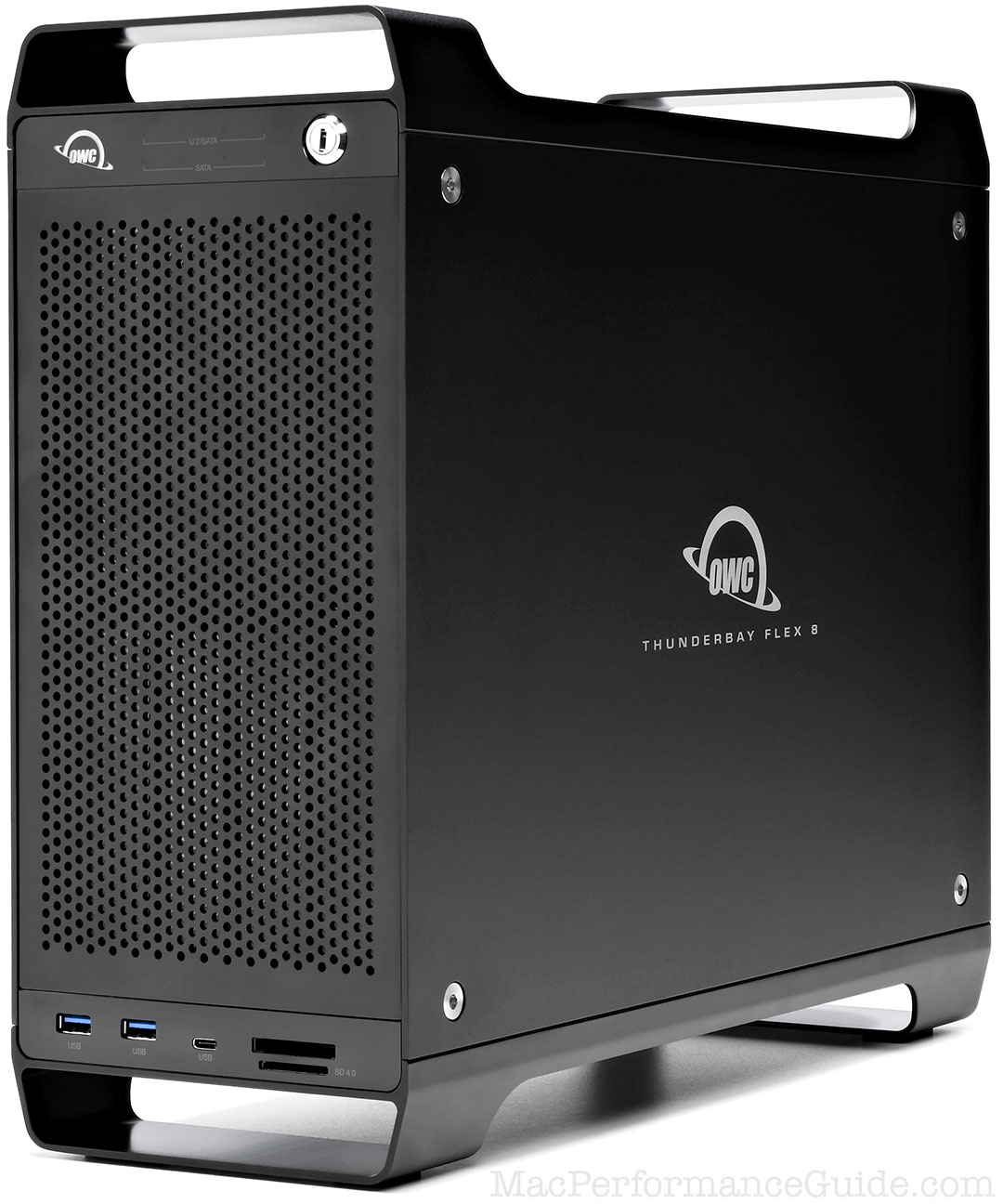
$220 SAVE $130 = 37.0% Western Digital 16.0TB Western Digital Ultrastar DC HC550 3.5-in… in Storage: Hard Drives
|

|

|

|

|
Inverter/Chargers: Xantrex Freedom XC
Photographer and cyclist and Mac expert and software engineer Lloyd Chambers is available for consulting on general Sprinter considerations at his usual consulting rates via phone, or in person in the Palo Alto, CA area. Save yourself hours and mistakes by discussing issues up-front. More about Lloyd....
Get your batteries and alternator and regulator (the whole kit!) from NationsStarterAlternator.com.

See the general inverter page for more on DC to AC power inverter/chargers.
The Xantrex Freedom XC inverter charger is about $750 @AMAZON (the Xantrex Freedom X is an inverter only, and costs less). Its timing was fortuitous, being released for sale about a week before I had the Xantrex 3012 installed, which is why I had not considered it prior. See also the Xantrex Freedom XC datasheet.
I initially chose the Xantrex Freedom 3012, a 3000-watt inverter/charger (discussed below). The Freedom 3012 is a premium unit, but it is really designed for very large power demand situations, and it turned out to be unworkable for me for several reasons:
- First and foremost, the Xantrex 3012 is just too large for my Sprinter van; I have no good place to it without losing critical foot/leg room and key storage space for stowing large camera bags and full-size computer displays while driving. It is very heavy and a custom mount could have been done, but it would still have intruded too much and cut down my usable space in critical areas.
- Cabling proved difficult with AC power conversion cutting out just past 1500 watt, because cabling and battery voltage drops could not maintain voltage above the 12.1V cutoff starting around 170 amps (2050 watts). So the 3000 watt continuous rating was problematic because of power input (I made changes to address that, but the headroom was still limited). I later doubled-up the cabling, but the fact remains that beyond 2000 watts gets iffy in terms of voltage loss.
After installing the Xantrex 3012 and finding it to be an excellent unit in general (just not for my purposes and limitations), I decided upon the Xantrex Freedom XC 2000 watt inverter/charger (rated for 1800 watts continuous at up to 104°F). The Freedom XC is also rated for full power output from -4°F to 104°F, not as robust as the Xantrex 3012, but at 28°F in the cabin is a good rating and once warmed up that is not a limit for cold.
The Xantrex Freedom XC cuts power output above 104°F, but my usage of its capacity is fractional most of the time—I can live with that no problem.
The Freedom XC is available in 1000 watt and 2000 watt versions but with an identical form factor, it makes little sense to go with the 1000 watt model since it is best not to ask the inverter to deliver more than half its rated power. Also, the shore power charging amps is higher with the 2000 watt model.
The key factors that attracted me to the Xantrex Freedom XC:
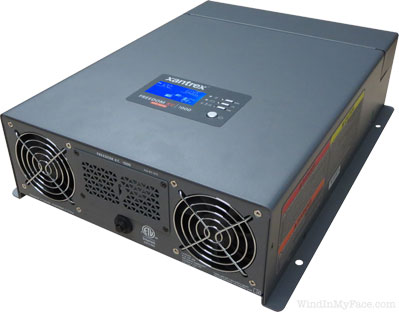
- The right form factor freeing up critical space. At 15.4 X 10.8 X 4.0 inches, the flat profile means it can be installed right behind the driver seat box and several other locations in my van. As well, its 16.3 pound weight is far more manageable to mount and support versus the whopping 74-pound Xantrex 3012, which requires special provisions if it is to be mounted in any way in a Sprinter van but bolted onto the floor or the wall (wall was not an option for me).
- The Power rating of 1800 watts continuous is ample, particularly given the challenges of maintaining sufficient voltage which make 3000 watts unrealistic anyway.
- It is an inverter/charger and it charges at 80 amps (88 amps or so to work = ~1250 watts), which won’t overload my household outlets.
- It has a very nice built-in status panel with an optional remote.
- It has an optional dual GFCI AC outlet panel.
- Its DC-in ports are ideal for the way I want to place them (fans out for maximum cooling, DC near van wall for shorter cable run).
Installed
Below, the Xantrex XC has been installed by bolting it to a cloth-covered wooden support which is itself bolted into the seat box under the driver’s seat. At about 17 pounds, this arrangement is rock solid for the Xantrex XC—far easier to deal with than the 75-pound Xantrex 3012.
As well, the critical under-table area has been freed up for feet/legs and stowage for camera packs and tripods and similar items while driving—the Xantrex 3012 made that impossible and thus unacceptable. In this configuration, the Xantrex XC occupies only 4 inches of space right behind the driver seat box, space which might otherwise be dead space anyway. It fits (barely); it must be positioned very precisely to work as shown—but it works well when positioned just right.
The status panel allows setting all the operational parameters as well as viewing status of various kind (voltage in , amperage in/out, watts, etc). Its one fault is poor viewing angle, which is why the status is not easily seen at this angle, and why I purchased the remote status panel, which had not yet arrived as I shot and so is not attached/installed.
See also the wiring layout (battery, wiring panel, inverter).
Tests and observations follow below.
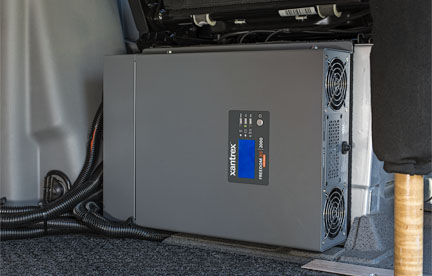
Xantrex Freedom XC charging settings
These settings were confirmed by Lithionics for the Lithionics 400 amp battery. Other settings may apply for different battery brands or types.
These settings are relevant for shore power charging and irrelevant to charging via the alternator.
#20 Battery Type: USE (custom)
#21 Battery temp: Warm
#22 Absorb voltage: 14.6V (presumably the same for bulk, no custom setting for bulk)
#23 Float voltage: 13.4V
#24 Charger current: 80 amps
With the Xantrex Freedom XC, temperature compensation is a manual setting (no sensor). Lithionics states to NOT use temperature adjustment with their battery—leave it at the default of Warm. Lithionics also states to NOT use a temperature sensor if an inverter has one (at least for the Lithionics 400 amp battery I chose).
Note that while the engine is running, the Mercedes Sprinter alternator in effect delivers 14.2V float voltage, because there is no voltage regulator when cabling the alternator directly to the battery. Lithionics suggests periodic shore power recharging for longer battery life:
Please change your Xantrex Freedom XC float value to 3.35 volts per cell or 13.4 volts. This permits a healthy micro-cycling of the battery to exercise it, and this will prolong life.
This advice has relevance for the 2nd alternator with Balmar-type regulator:
Best practice is to have a correct float voltage: 13.4V this will give it max cycle life.
Having an alternator that simply outputs 14.2V no matter what "works" but isn't the best practice. This is where matter of opinion comes in compared to application and usage cycle.
Ideally/best practice you'd want an alternator regulator that would control the alternator to output 14.6V for x time (or until x amps) and then reduce the alternator to output voltage of 13.4V float. We do this a lot in marine industry with Balmar or equivalent alternator regulators. It seems to me it's not common in RV industry since it's more costly and complex.
Not knowing the exact usage, 14.2V should be OK, but when on shore it should charge at 14.6V to both allow rebalancing of cells and reset/calibrate SOC meter to prevent drift.
My take here is that when I return home after a trip, it is worth discharging by 80%, then to run shore power charging to full, using the appropriate settings above.
The advice above puzzles me, because with the Xantrex Freedom XC, at no time do I see 14.6 volts at the battery terminals, nor 13.4 volts during float stage.
8-bay Thunderbolt 3
2.5 or 3.5 inch hard drives, NVMe SSD, USB-C, USB-A, DisplayPort 1.4, SD slot, PCIe slot, 500W power supply.
Non-RAID or RAID-0/1/4/5/10.
Capacities up to 128 Terabytes!
Xantrex Freedom XC charging behavior
For this test, I first drained the Lithionics battery to 14% SoC (State of Charge), using the Aerus Apollo 2000 Infrared Space Heater @AMAZON to place a steady load on the inverter of about 1440 watts (AC output from inverter) along with some small DC loads, all total a load of about 1750 to 1800 watts from the battery—see discharge test below.
The Xantrex Freedom XC was set to 14.6V ABSORB voltage and 13.4V float voltage, as per the settings above.
*** At least with firmware as of Oct 1 2017, 14.6V is too high a charge setting: Xantrex advised lowering to 14.4V. This did *not* overshoot on voltage. ***
From 14% SoC, time figures approximate. Voltage as measured at the battery terminals started out at 13.6V, then rose to 13.7V for nearly 4 hours, but no higher voltage was seen.
03:00 = 72% SoC (3 hours in)
03:45 = 86% SoC
04:30 = 99% SoC (probably 4:15 or so, but did not catch it exactly)
When finished at 04:30, battery reads 5337 watt hours at 99% SoC at +3 amps and battery terminals measured at 13.7 volts (charger off). Shortly thereafter and with shore power removed, the terminals measured at 13.7 volts for a short while, then dropped to 13.6 volts (with 0 amp draw).
During bulk charge phase, I never saw the voltage at the battery terminals rise above 13.7 volts even though the Xantrex Freedom XC was set for 14.6V charging for “Absorb” as per the recommended settings above. Since I never saw the Xantrex Freedom XC enter the ABS (absorb) phase, presumably this was of short duration and happened sometime between 86% SoC and 99% SoC.
Accordingly, I ran a shorter test the next day, this time starting with the Lithionics battery at 94% SoC, data shown in the table below. There were three curiosities:
- The ABS (absorb) phase was extremely short, perhaps 15 seconds.
- In FLT phase, there was no input current; the battery status panel read 0.4 amps, which means 0.4 amp draw.
- The battery shut itself of shortly after the charge cycle ended. Was this some kind of self protective behavior?
- The battery reverted to 99% SoC when powered back on. Indeed, overnight it seems to lose 2% SoC with only 0.4A indicated draw—why?
Shown below, with firmware as of Oct 1 2017, 14.6V is too high a charge setting; it triggers the over voltage protection on the Lithionics BMS system. Charging voltage should be reduced to 14.4 volts until/unless the firmware bug is fixed. That 14.4V does not overshoot when charging from a shallow or medium or deep discharge has been directly verified.
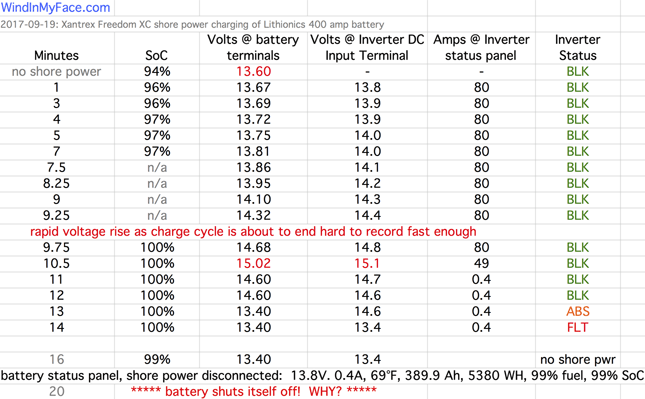
Xantrex Freedom XC discharge behavior under high draw
For this test of the drained the Lithionics 400 amp battery, the Aerus Apollo 2000 Infrared Space Heater @AMAZON was used to place a steady load on the inverter of about 1440 watts (AC output from inverter) along with some small DC loads, all total about 1800 watts from the battery, as indicated by the Lithionics status panel wattage and amperage figures.
Load totaled 1750 to 1800 watts DC for these figures:
60% SoC: ~140 amps @ 12.6V (12.55V measured at battery terminals, inverter reads 12.1V, but 12.41V measured at inverter terminal)
28% SoC: ~144 amps @ 12.3V (inverter reads 11.8V, but continues to be 0.4V to 0.5V low versus multimeter reading)
15% SoC: ~144 amps @ 12.1V (inverter reads 11.5V, but reads 0.5V low as per multimeter at its DC input terminal)
14% SoC, load removed: 3 amps @ 12.6V, inverter reads 12.7/12.6V (alternating)
DC to AC Conversion was at best about 85% efficient in the test, below what Xantrex claims as the minimum.
Xantrex Freedom XC voltage discrepancy
The Aerus Apollo 2000 Infrared Space Heater @AMAZON was used to place a steady load on the inverter of 1470 watts (AC output from inverter).
The DC voltage drop calculator predicts a voltage drop of 0.11 volts for an estimated 4 feet of 1/0 gauge cable. However, matters are more complicated: there are dual 1/0 cables from battery to the wiring panel, but also multiple connector endpoints involved as well as circuit breakers,so it’s a guessing game. Still, sticking with 4 feet of 1/0 cable as our length estimate:
Calculated: 0.11V drop
Actual: 12.78 - 12.61 = 0.17V
The discrepancy is reasonable given the estimated length of cable and the breakers in-between and the fact that multiple connector endpoints are involved.
Voltage, Lithionics status display: 12.8V
Voltage at battery terminals (multimeter): 12.78V
Voltage at wiring panel exit (multimeter): 12.69V
Voltage at Xantrex DC input terminal (multimeter): 12.61V
Voltage, Xantrex claim: 12.4V
The Lithionics status panel matches the multimeter voltage (it rounds to 1/10 volt).
The multimeter has proven itself to be consistent with values at the battery as well as a professional volt meter at an auto shop.
The Xantrex Freedom XC voltage reads low by 0.21 volts versus the reading of 12.61V as read by the multimeter at the DC input terminal of the Xantrex inverter. It is not credible that 0.21 volts is lost from the copper connector attached to the Xantrex DC input terminal. Hence one has to conclude that the Xantrex voltage display is incorrect, or that it is measuring voltage somewhere else (internally)—but it is also hard to believe that it could lose 0.21V internally.
Below, about 3 amps are being taken by other DC devices (lighting), so the battery is outputting about 135 amps @ 12.78V at the battery terminals (1724W), degrading into 12.61V at the Xantrex inverter to support an AC output load of 1470 watts . That implies a DC-AC conversion efficiency of 1470W/1724W = 85.2%. This is below the specified full load efficiency of >= 87.5%. If the Xantrex input voltage is taken to be 12.4V as shown, that implies 12.4 * 135 = 1674 watts which implies an efficiency of 1470/1674W = 87.8%, which is within the specified efficiency range. How these differing voltages and efficiency can be reconciled is unclear.
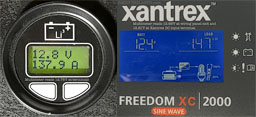
Seagate 22TB IronWolf Pro 7200 rpm SATA III 3.5" Internal NAS HDD (CMR)
SAVE $100



